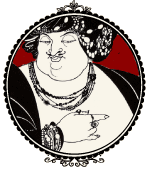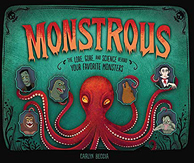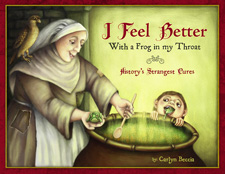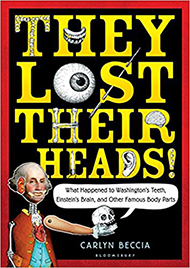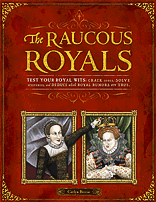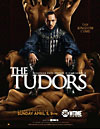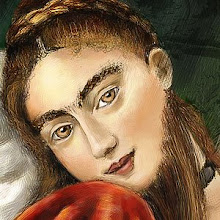The Raucous Royals got a starred review from Publishers Weekly!! Read the full review here.
And thank you to Cynthia Leitich Smith for featuring The Raucous Royals this week at Cynsations.
Tuesday, September 30, 2008
Sunday, September 28, 2008
Royal Vapors and Foul Rumors
 This week’s post is about a dangerous and deadly substance feared and avoided by many royals throughout the 16th – 18th century.
This week’s post is about a dangerous and deadly substance feared and avoided by many royals throughout the 16th – 18th century.In 1568, Ambroise Pare, the royal surgeon who lived to see the reigns of Henry II, Francis II, Charles IX and Henry III, warned that when this diabolical substance came near an unsuspecting victim, “the flesh and the whole disposition of the body are softened and the pores open, and as a result, pestiferous vapour can rapidly enter the body and cause SUDDEN DEATH, as has frequently been observed.”1 (Emphasis added for my own dramatic effect.)
In 1655, French doctor Theophraste Renaudot expounded upon Pare’s beliefs when he said that this deadly matter “fills the head with vapors. It is the enemy of the nerves and ligaments, which it loosens limbs…2”
 What sort of bizarre substance could loosen limbs, soften pores and even cause death? Here are the choices:
What sort of bizarre substance could loosen limbs, soften pores and even cause death? Here are the choices:A. Plague air
B. Sunlight
C. Eating Vegetables
D.Water
Scroll down for answer….
Keep scrolling you fool
You know you have nothing better to do
Almost there…
Correct Answer: D
Water was the deadly substance in question. Many doctors of the 16th and 17th century would not have advised bathing on a regular basis. In Louis XIV's court, pregnant women were told NEVER to bathe because it was believed to relax the womb. With all this dirt building up, did royals really stink to high heaven? We have a rough idea of what royalty looked like, but what did they smell like?
Kings and queens certainly didn’t bathe every day, but they also didn’t walk around with grime stuck in their fingernails either. In fact, some royals got downright creative when it came to what they put in their bathwater. Here is what some famous people may have smelt like...
Bubbles, Candles and a little Asses Milk
 Louis XIV liked a little lavender in his bath. (more on him later)
Louis XIV liked a little lavender in his bath. (more on him later)Henry VIII bathed at Hampton Court with actual heated water pumped in from a stove in the adjoining room. To ease the pain in his sore leg, he soaked in a mixture of herbs, musk and civet . A civet is a small carnivorous cat that supposedly gives off a very distinctive musk. I am not exactly sure what cat musk smells like, but I am not imagining it to be pleasing.
Like many people of his day, Henry also went to bed with a piece of fur so that fleas and lice would jump on it and not on his royal skin. This begs the question....wouldn't the fleas be confused if you smelled like a dead cat?
Mary Queen of Scots bathed in wine. If I ever win the Newbery, Caldecott or get that call from Oprah, I am going to try this one.
 While other courtiers were slathering on heavy, white, lead makeup, the mistress of Henri II, Diane de Poiteirs took the au natural approach and bathed in rain-water. All these nature baths must have worked for despite the fact that she was 19 years older than the king, she held him enthralled until his death.
While other courtiers were slathering on heavy, white, lead makeup, the mistress of Henri II, Diane de Poiteirs took the au natural approach and bathed in rain-water. All these nature baths must have worked for despite the fact that she was 19 years older than the king, she held him enthralled until his death.Cleopatra famously bathed in Asses milk to keep her skin youthful and fresh. Ironically, this one may have really worked. Donkey’s milk contains oligosaccharides which increase the number of good bacteria and have anti-aging properties.
While suffering from a "distressing malady" Countess Platen Hanover bathed in milk and then generously donated the diseased milk to the poor. Charity sometimes began in the tub.
Clad in her flannel nightgown, Marie Antoinette bathed in a sweet concoction of pine nuts, blanched sweet almonds, marsh mallow root, Lilly bulbs and a candy paste made from roots and syrup called enula-campana. So Marie Antoinette probably smelled like fresh baked cookies with some floral undertones. Yummy.
 Mirror Mirror on the Wall....Who is the Dirtiest of them ALL?
Mirror Mirror on the Wall....Who is the Dirtiest of them ALL?Which royals hardly ever bathed? Here’s a whiff into some royal tubs.
Anne of Cleves
The Germans had long shocked the rest of Europe by not washing their hands before eating and bathing infrequently. Henry VIII’s forth wife, Anne of Cleves was no different. Before she was presented to Henry, her advisors worked hard to get the stinky German Princess to take a bath.
Elizabeth I
Rumors abound that Elizabeth professed that she bathed once a month, “whether she needed it or not.” 3 But given Elizabeth's keen sense of smell and her access to the sunken bath that her father built, I suspect she bathed far more often.
Peter the Great
Peter traveled the world learning new customs, but no amount of enlightenment could get the czar practicing good hygiene. He found nothing wrong with relieving the call of nature on the glittering palace walls. These were good times to be a germ. Peter did swear by the curative properties of an occasional natural mineral spring bath, but didn't make a habit out of bathing regularly.
Ferdinand and Isabella
Ferdinand and Isabella didn’t help in the quest toward cleanliness. In Spain, the early Christian doctrines taught that bathing was a corrupt practice that could only lead to…nakedness. Cleanliness was next to Ungodliness. After the conquest of Granada, the Moors not only had to give up their religion to survive the Inquisition, they also had to give up bathing. Isabella and Ferdinand ordered the Moorish baths to be destroyed and bathing was strictly forbidden. When Columbus reported back on the daily bathing habits of the Taino people, Isabella was horrified and commanded her new subjects to stop this blasphemous bathing practice at once.
Isabella boasted that she herself had only bathed twice in her life and I am going to take her word for it.
Phillip II and his Daughter Isabella
Continuing along with the Spanish love of dirt, Phillip II banned the remaining bath houses in 1576. His daughter Isabella because a national martyr to germs when she vowed in 1601 that she would not change her shift until the siege of Ostend ended. Unfortunately, the siege lasted over three years! Eeeeeuw…. that’s an awfully long time to be wearing the same underwear. After three years, her white shift had turned a lovely shade of brown.
Henry IV
Henry’s first wife, Marguerite de Valois complained bitterly about Henry’s lack of bathing worsened by his proclivity to eat large amounts of garlic.
 Rub a Dub Dub- My Favorite King and his Tub
Rub a Dub Dub- My Favorite King and his TubOne king that always gets accused of being dirty (in more ways then one) is Louis XIV. I have read several trivia type books containing the rumor that Louis XIV bathed “only three or two times in his life”. Search on the internet and you will find this rumor everywhere. But is it really true?
The ruling theory of the time was that simply changing your linen would soak up sweat and dirt. The rich wore tightly woven fabrics like linen and taffeta because it was believed to keep the crawlies and unseen plague away from skin. Loosely woven fabrics like wool were believed to be far less effective in staying clean.
The king’s morning ritual consisted of his hands and face being wiped down with spirits and then his sweat-drenched linen was changed (Louis reportedly sweat a lot). His courtiers then sent him on his way to go to mass, his council meeting, hunt, chase the ladies and work up some more sweat. His linen was then changed a couple of more times throughout the course of the day. In all fairness to this daily routine, most courtiers did not change their linen more than once a day so Louis is already looking pretty clean in comparison.
But if linen didn’t succeed in keeping the king clean, he could always retire to his Appartement des Bains located on the ground floor at Versailles. The Appartment des Bains was a private space created for “informal” meetings and washing. They contained a suite of rooms for disrobing and included an enormous bed situated before a large mirror. (Louis had a bit of a thing for mirrors) Louis would bathe in his long, grey smock of course linen and used a soap made from olive oil. The “cabinet des bains” contained his octagonal bath inset in the marble floor about 10 feet wide and 3 feet deep. It was decorated with Azurian gold, themes of Juno and flanked by marble columns. Pillows adorned the bottom of the bath and a wood burning stove provided heat to the perfumed water that filled it. Sounds like a good time to me.
But now before your minds get all dirty….The Apartement des Bains was more than just Louis’s playboy suite with built in Jacuzzi. It was also his inner sanctuary. As a boy, he spent many lazy hours relaxing with his mother Anne of Austria. According to Anne’s valet, La Porte, Louis would literally jump for joy whenever he joined his mother in her bath. Bathing and cleanliness was an ideal that Anne further instilled in the young boy by always insisting that his hands and fingernails were washed regularly.
Louis was also an avid swimmer and enjoyed bathing in the Seine. In the summer months, Henriette Anne (married to Louis’s brother) and her ladies covered themselves in long shifts and went for a little dunk in the river. You can bet Louis didn't pass up the opportunity to splish splash with the ladies clad in only their shifts. Now, you might argue that swimming doesn’t count as bathing, but in 17th century France, swimming was done to clean the body. Many superstitious Europeans believed that swimming in the open air on the feast of St. John the Baptist would even protect them from sickness. Remnants of this belief still exist today. People might look at you strange if you called your bathing suit a “swimming suit.”
Tracing this Dirty Rumor
Bathing was obviously not a regular occurrence, but Louis washed far more than 2 or 3 times in his entire life. So where did this rumor come from? We will never know for certain how it got started, but I suspect that somewhere along the line Louis’ “medicinal” bath got confused with the frolicking he did in his private quarters. Louis' medicinal bath was given by his personal doctor, Guy-Crescent Fagon, and consisted of bleeding, purging, freezing cold water and the always popular enema. Excuse the bad pun, but simply put…. the sun didn’t shine where they cleaned the sun king. Louis doctors believed it was far more important to clean the inside of the body than the outside. This bath was not the playful splashing of lavender scented water that Louis enjoyed with his mistresses. Louis reportedly felt awful afterwards and allowed this Nurse Ratchet bath to be given to him only twice in his life then promptly swore he would never allow it again. Fagon reported, “The king was never pleased to become accustomed to bathing in his chamber.”4 The key words here are “his chamber.” What happened on the bottom floor of Versailles was an entirely different story.
 Another source of this rumor may have been Louis mistress, Madame de Montespan’s, defensive practices against offensive smells. She doused herself in clouds of perfume to mask Louis’s odor. Montespan was not trying to necessarily cover up Louis animal musk, but instead his horrendously bad breath. Brushing teeth WAS a serious problem and best saved for another post….
Another source of this rumor may have been Louis mistress, Madame de Montespan’s, defensive practices against offensive smells. She doused herself in clouds of perfume to mask Louis’s odor. Montespan was not trying to necessarily cover up Louis animal musk, but instead his horrendously bad breath. Brushing teeth WAS a serious problem and best saved for another post….Read more about Louis and his bathing habits in the illustrated picture book The Raucous Royals.
Who is your favorite dirty royal? What do you think they smelled like?
 If you would like to learn more about the history of bathing then I highly recommend Katherine Ashenburg's The Dirt on Clean: An Unsanitized History. Although Ashenburg does argue that Louis was amongst the unwashed, I will concede that she is right if you judge him in the context of modern day cleanliness. Overall, her detailed research is undeniably thorough and there are much more intriguing tidbits of bathing history that I did not mention in this post.
If you would like to learn more about the history of bathing then I highly recommend Katherine Ashenburg's The Dirt on Clean: An Unsanitized History. Although Ashenburg does argue that Louis was amongst the unwashed, I will concede that she is right if you judge him in the context of modern day cleanliness. Overall, her detailed research is undeniably thorough and there are much more intriguing tidbits of bathing history that I did not mention in this post.Sources & Notes:
(1) Ashenburg, p.94
(2) ibid, p. 100
(3) ibid, p. 99
(4) ibid, p.116
Feydeau, Elisabeth de & Lizop, Jane. A Scented Palace: The Secret History of Marie Antoinette's Perfumer, I. London: I.B. Tauris, 2006.
Albuquerque de , Martim & White, William. Notes & Queries: 2nd S. No. 45 Oct. 25. '56. Oxford University Press, 1856 .
Ashenburg, Katherine. The Dirt on Clean: An Unsanitized History. New York, NY: North Point Press, 2008.
Frieda, Leonie. Catherine de Medici. London: Phoenix, 2005.
Erickson, Carolly. Great Harry. New York, NY: St. Martin's Griffin, 1997
Folkestone Williams, Robert. Memoirs of Sophia Dorothea, Consort of George I. Published by H. Colburn, 1846. Digitized book available.
Louis XIV and Bathing
Louis XIV and Bathing: Hilton, Lisa. Athenais: The Life of Louis XIV's Mistress, the Real Queen of France. New York, NY: Back Bay Books, 2004.
Lewis, W.H. The Splendid Century: Life in the France of Louis XIV, Long Grove, IL: Waveland Press, 1997 .
Pictures of Appartement des bains and recreated rooms accessed online
Ashley, P. Marice. Louis XIV And The Greatness Of France, New York, NY: Free Press, 1965
Levi, Anthony. Louis XIV. New York, NY: Carroll & Graf Publishers, 2004.
Fraser, Antonia. Loves and Lives of Louis XIV. New York, NY: Anchor, 2007.
Mitford, Nancy. The Sun King: Louis XIV at Versailles, New York, NY: Penguin, 1995
Monday, September 22, 2008
Royal Monkey Business
 I’ve been thoroughly enjoying the binge drinking monkeys over at Got Medieval, but why should the medieval revelers have all the fun? You can find plenty of monkey antics in royal courts too.
I’ve been thoroughly enjoying the binge drinking monkeys over at Got Medieval, but why should the medieval revelers have all the fun? You can find plenty of monkey antics in royal courts too.For example, take the Medici court. Despite their reputation as the omnipotent godfathers of Florence, they loved a good monkey prank just as much as the next person. Some of this monkey business can be found in the following account describing a scuffle between the Medici court’s favorite dwarf, Pietro Barbino (possibly depicted in the this statue) and a ferocious monkey:
“There was a bit of entertainment in the form of a combat between the dwarf and a really good monkey that belongs to the Provveditore.The dwarf had two injuries, one in the shoulder and the other in the arm, while the monkey was left with his legs crippled. The monkey eventually gave up and begged the dwarf for mercy. The dwarf, however, didn’t understand the monkey’s language and having seized the monkey by the legs from behind, kept beating his head on the ground. If My Lord the Duke [Cosimo I de’ Medici] hadn’t stepped in, the dwarf would have gone on to kill him. The dwarf fought naked, having nothing to protect him except a pair of undershorts that covered his private parts. Suffice it to say that the dwarf was the victor and he won ten scudi in gold, which had been secured by pledging the ring of the Bishop of Forlì [Bernardo de’ Medici].”
Archivio di Stato di Firenze, Mediceo del Principato 1171, insert 2, folio 62 (Entry 6488 in the "Documentary Sources" database.)
When was the last time you saw a naked dwarf wrestle an angry monkey? If Cosimo had not stepped in…all my scudi would have been on the naked dwarf. And what if the monkey had put up a better fight? Well then we might not ever appreciate this great piece of art immortalizing Pietro Barbino flashing his bits in the Boboli gardens. Monkeys can change the course of history.
 Monkey Portraits
Monkey PortraitsAnd like the medieval monkeys (which btw would be a great name for a children’s book), royal monkeys were also portrayed in art. Pet monkeys were the hairless dogs of their day. Only the rich could afford them in their menagerie so they became regal status symbols. They also gave a lighthearted feel to a painting and could more directly symbolize controling your monkey lust. The painting to the left is of Catherine of Aragon and is believed to have been commissioned around 1530. An earlier painting depicting the same subject is dated at 1525. Around this time, Henry VIII started to monkey around (sorry...couldn't resist) with Anne Boleyn and began seeking a divorce from Catherine. This divorce would eventually lead to his break from the Catholic Church.
Notice how the monkey grabs at the cross. Could the monkey symbolize Henry? Is the artist saying, “Henry's a silly monkey to go against the Catholic religion” Or maybe the monkey symbolizes Anne Boleyn and the artist is saying, “you’re a fool to play with religion. And btw, you look like a monkey.”
Anne did hate monkeys so my guess is on the latter.
Love Me...Love my Monkey
 In Catherine the Great's court, every courtier fought for an audience with the young, foppish favorite of the queen - Plato Zubov. Zubov was an audacious 22 to Catherine's 60, but age didn't matter much to the ailing queen. Catherine trusted Zubov enough to handle the political dredgery of meeting with generals, foreigners and royal butt kissers in search of favors. Yet royal courtiers best hold on to their wigs if they sought a meeting with Catherine's studly gatekeeper. Zubov's monkey was known to amuse both himself and his master by jumping on shoulders and stealing wigs right off the heads of unsuspecting visitors. The eager courtiers were forced to endure, but everyone knows that there is nothing funny about a monkey stealing your wig.
In Catherine the Great's court, every courtier fought for an audience with the young, foppish favorite of the queen - Plato Zubov. Zubov was an audacious 22 to Catherine's 60, but age didn't matter much to the ailing queen. Catherine trusted Zubov enough to handle the political dredgery of meeting with generals, foreigners and royal butt kissers in search of favors. Yet royal courtiers best hold on to their wigs if they sought a meeting with Catherine's studly gatekeeper. Zubov's monkey was known to amuse both himself and his master by jumping on shoulders and stealing wigs right off the heads of unsuspecting visitors. The eager courtiers were forced to endure, but everyone knows that there is nothing funny about a monkey stealing your wig.I am sure there are plenty more monkey tales, but those are the ones that stick out in my mind.
Sources and Further Reading:
The Medici Archive Project. Referenced online at: http://www.medici.org/news/dom/dom012002.html
MacDonogh Katherine. Reigning Cats and Dogs. New York, NY: St. Martin's Press, 1999.
Troyant, Henri. Catherine the Great. New York, NY: Penguin Group 1994
Wednesday, September 17, 2008
Your Pocket Watch is Ticking....
2 more days to head over to Scandalous Women and enter to win a copy of The Raucous Royals. Entering is as easy as losing your head in Henry VIII's court. Just comment on the Jane Boleyn post and...Voila you're in.
Monday, September 15, 2008
The Flanders Mare - A Promiscuous Horse?
 Historians have often wondered why Henry did not find his fourth wife, Anne of Cleves appealing. Part of the mystery lies in the fact that we have very few accounts describing her appearance and only two contemporary portraits. One portrait is the infamous betrothal portrait by Holbein which sealed her fate and the other is from the workshop of Barthel Bruyn the Elder (shown below).
Historians have often wondered why Henry did not find his fourth wife, Anne of Cleves appealing. Part of the mystery lies in the fact that we have very few accounts describing her appearance and only two contemporary portraits. One portrait is the infamous betrothal portrait by Holbein which sealed her fate and the other is from the workshop of Barthel Bruyn the Elder (shown below).Writers through the years have certainly not been kind to Anne. The reference to Anne looking more like a "flanders mare" than a princess was first made in the 17th century by historian Gilbert Burnet who critisized Holbein's painting as taking, "the common compliment of his art too liberally." Nothing could be futher from the truth. Holbein was known for his accuracy and attention to detail in his paintings. Most importantly, the whole purpose of sending him to paint Anne was to take a likeness. He did his job and was therefore never punished by Henry when the real life Anne did not meet his expectations.
Later historians have speculated that Anne was unattractive to Henry because she was “large-boned,” but I disagree with this assessment. Anne was reportedly tall and the layers of clothes certainly made her look like a stuffed sausage, but I suspect that Anne's body type may have been closer to thin and gangly than big-boned. I have already written about some of Anne’s finer qualities in a previous post.
 Find Me a Woman with Some Meat on Her Bones
Find Me a Woman with Some Meat on Her BonesBefore marriage negotiations began with Cleves, Henry had instructed his advisors to find him a heavy-set woman for his fourth wife. His exact words (and a bit of an understatement) were, 'I am a big man and in need of a big wife.' Yet, Henry contradicted his own words with his previous actions for he tended to be more attracted to small-hipped women like Anne Boleyn and Jane Seymour. Perhaps his days of slim women were over at the point in which he began marriage negotiations for his fourth wife?
Digging deeper, there is obviously more to attraction then someone's body build. And we also can't forget about Henry's political motivations toward the marriage for he may have simply not needed the alliance with Cleves as the marriage progressed. But Henry was obviously very much repulsed by his new bride too.
What did repulse Henry enough to annul the marriage and make Cromwell a head shorter?
The clue may be in the infamous rumor that Anne looked like a “Flanders Mare."

What is a Flanders Mare?
A Flanders Mare is not the graceful and delicate horse of a queen. In Medieval times, Belgium Horses were prized in wars for their tremendous size and strength. (show above).
Colored like a Flanders Mare
These heavy, war-like draft horses were typically black and ranged from colors to bay, bay-brown to chestnut. They were rarely lighter colors like they are today. Many accounts report that Anne was of a darker skin tone, the opposite of the beauty ideal of the time. When Henry asked Lord Russell what he thought of his new bride he replied that 'I take her not for fair, but to be of a brown complexion.'
Smells Like a Flanders Mare
I grew up around horses. I love horses. But let's face it. No matter how much you love horses you cannot deny that they stink. One of the biggest turn-offs for Henry was Anne's lack of hygiene. Maybe it was her smell that truly repulsed him? But wait....I have an even more far fetched theory.
As Skanky as a Flanders Mare?
Henry also told Anthony Denny, a member of the Privy Chamber, that she had 'breasts so slack and other parts of body in such sort that [he] somewhat suspected her virginity.' And if that was not bad enough he complained to his court physician of the 'hanging of her breasts and looseness of her flesh.' Could Henry have really suspected Anne's virginity?
 Later in the 17th century, Flanders Mares were not only prized for their strength, but also their eager willingness to pull heavy carriages. The Flanders Mares were mentioned in the diary of Samuel Pepys:
Later in the 17th century, Flanders Mares were not only prized for their strength, but also their eager willingness to pull heavy carriages. The Flanders Mares were mentioned in the diary of Samuel Pepys:Thence to my Lord’s, where I found Mr. Pierce, the surgeon, and with him and Mr. Sheply, in our way calling at the Bell to see the seven Flanders mares that my Lord has bought lately, where we drank several bottles of Hull ale. Much company I found to come to her, and cannot wonder at it, for she is very pretty and wanton.1
Pepys never really says who the “her” is but he seems to be making a double entendre between the horse wantonness and the unknown women. Interesting that he chose the always willing Flanders Mare to make his comparison. Perhaps the word "wanton" had a different meaning then? I suspect it means relatively the same thing.
In the eighteenth century, English writer and pamphleteer Daniel Defoe gives the prostitute and main character of his novel the fictitious name of Moll Flanders. He makes it clear that this is not her real name. In general, Defoe rarely named his characters and generally referred to people as “the elder brother” or “the nurse.” I doubt Defoe's choice of Flanders was insignificant.
I personally believe that Henry was not attracted to Anne because of a combination of factors. She lacked refinement and grace (she couldn’t dance or play an instrument), her darker complexion was not the beauty ideal of the time, she smelled when Henry was fastidious about cleanliness, and most importantly she may have exhibited an eagerness to please that Henry found unattractive. Aside from Henry's political motivations toward the match, we will never know for certain why the science of attraction failed, but perhaps if Anne had played hard to get she might not have reminded Henry of this eager draft horse.
Sources
Starkey, David. The Six Wives of Henry VIII. New York, NY: Harper Perennial, 2004
Weir, Alison. The Six Wives of Henry VIII. New York, NY: Grover Press, 1991
Pepys, Samuel. The Diary of Samuel Pepys, Hayes Barton Press, 1660 - can be accessed online in Google Books.
Warnicke, Retha M. The Marrying of Anne of Cleves: Royal Protocol in Early Modern England, Cambridge University Press, 2000
Daniel Defoe Wikipedia Entry
Notes:
1: Weir (p.227 )
Labels:
Anne of Cleves,
Flanders Mare,
Henry VIII,
Raucous Rumors
Monday, September 8, 2008
Will the real fat Jonathan Rhys Meyers please stand up?
 As most fans of the Tudors already know by now, Jonathan Rhys Meyers will not be donning the fat suit to play Henry VIII in his more portly years. I don’t think this comes as much of a surprise. The Tudors creators have stuck with their original intentions of showing a sexy and glamorous Henry VIII. At the same time, I can’t help but be disappointed and have created this slightly chubbier depiction of Meyers in hopes of visualizing what he might have looked like.
As most fans of the Tudors already know by now, Jonathan Rhys Meyers will not be donning the fat suit to play Henry VIII in his more portly years. I don’t think this comes as much of a surprise. The Tudors creators have stuck with their original intentions of showing a sexy and glamorous Henry VIII. At the same time, I can’t help but be disappointed and have created this slightly chubbier depiction of Meyers in hopes of visualizing what he might have looked like.I was really looking forward to seeing the talented Meyers stretch beyond eye candy this time especially after he had brilliantly portrayed Elvis, but again chose to depict him sexy and thin to the end (ironically….another king turned fat). I guess the producers were afraid that no one wanted to watch a fat Meyers, but I personally will find Meyer’s Adonis-like "appealing" physique distracting. Now, when he flashes his foreboding glares, it will come off as more of a sexy, harlequin romance, “I am going to ravage you” stare than the far more intimidating “I am going to chop of your head because I am so fat and uncomfortable.”
I could be wrong, but I suspect that fans of The Tudors care more about a dramatic portrayal of real events than what Myers is hiding in his codpiece. Sure, Myers might not have pulled off the sex appeal in a fat suit, but Henry VIII’s weight is a key component in showing his more irascible and mercurial nature. A thin Henry is not just exercising a little Hollywood creative freedom. It is completely untrue.
How will they portray the meeting of Henry and Anne of Cleves? Henry’s lack of sex appeal and burgeoning weight is a crucial element in portraying the couples’ botched first meeting. How can you tell Kathryn Howard’s story without the dramatic visual contrast of a nubile, and somewhat naïve girl thrown into the bed of a grotesquely overweight, aged man with the fetid smells of puss oozing from his leg? And how will they portray Katherine Parr’s more maternal role of nurse to her overweight, sickly husband? Will we see a virile king rolling in bed with his wife, when in reality he was too fat to even mount a horse or move from room to room without the help of a chair? Isn't half the fun of historical drama watching real people (warts and all) overcoming real obstacles? The decision to keep Meyers thin makes a mockery out of Henry’s story and assumes viewers care more for histrionics than history.
Yes, I will still watch, if anything, out of a morbid curiosity to see how events will be distorted. I just wish the producers had chosen to distort Meyer’s waistline instead of the truth.
Thursday, September 4, 2008
Win a FREE copy of the Raucous Royals
Throw on your petticoat, grab your parasol, button up your britches and rush on over to Picture Book Junkies to enter to win a FREE signed copy of The Raucous Royals.
Tuesday, September 2, 2008
Royal Bitches: How Dogs Ruled the Palace
 Throughout history, kings and queens have often shown their dogs far greater love and affection than their spouses or children. Here are just a few examples where dogs ruled.
Throughout history, kings and queens have often shown their dogs far greater love and affection than their spouses or children. Here are just a few examples where dogs ruled.Dogs first, People Second
Frederick the Great showed little attraction toward women and had no children. His beloved greyhounds were his real babies. His dogs had free reign of the palace including their own gallery where they could run amuck tearing the furniture to shreds and pooping in every corner. Frederick even erected a magnificent white marble mausoleum to his greyhounds after their death with plans for his own tomb to lie between them. His blatantly, ignored wife, Elizabeth Christine, could only hope for such honors.
Queen Victoria is famous for being "amused" by her dogs, but not so much by her children. To punish her grandson, George V, for his poor table manners, Victoria commanded him to eat under the table like a dog. In an effort to emulate the canine competitor for his mother's affections, George proceeded to remove all his clothing so that he could be (like a dog) unburdened by clothing in his punishment. It doesn’t take a psychologist to discern that Victoria’s children may have felt that they came in second place. Her own emotions toward those bundles of joy were expressed when she said of her babies,
 'til they have become a little human; an ugly baby is a very nasty object...and the prettiest is frightful when undressed...as long as they have their big body and little limbs and that terrible frog-like action.' 1
'til they have become a little human; an ugly baby is a very nasty object...and the prettiest is frightful when undressed...as long as they have their big body and little limbs and that terrible frog-like action.' 1Perhaps if her babies had been born with fur than her affections may have been different.
Peter the Great was also not much of a family man except when it came to his dogs. He showed little remorse after locking his sisters up in a nunnery and murdering his son, but his beloved dog, Finette was by his side every second of the day.
Dogs in the Bedroom
Dogs were often afforded luxuries that pandering courtiers could only hope for, including coveted access to the monarch’s bedchamber. Peter the Great’s miniature greyhounds slept in his bed sharing vermin and covers.
Catherine the Great’s boudoir was overrun with her husband, Peter’s 8-10 hunting dogs. She complained in her letters of the stench and the little presents they left on her pillow in the form of dog poop.
Napoleon was forced to share his bed with Josephine’s beloved pug, Fortune. During the Revolution, Fortune aided his mistress during her imprisonment in Carmes. The pugnacious pug smuggled secret messages hidden in his collar to Josephine’s children. Later, Napoleon would have to compete for Josephine’s affections with her loyal dog and complained,
‘As if a pretty woman could give up her routine, her friends, her Madame Tallien or a dinner-party at Barras’ house and the performance of a new play of Fortune, yes! Fortune! You love them all more than your husband…’ 2
Fortune put the jealous husband in his place by biting him on the leg.
Doctors in the Tudor age even prescribed putting a dog in bed with their monarch as the cure for stomach cramps. These dogs were called “comforters.” A puppy as a cure may sound like quack medicine, but you could actually view it as the forerunner of the hot water bottle. I personally would take a warm puppy over a hot water bottle or heated pad any day.

Throughout the 16th –19th century, dogs also controlled vermin in the palace and bedroom. (Cats had a hard time finding work because they were considered vermin themselves.) Louis XI took great pride in watching his mice-catching dogs working while he lay in his bed. Queen Victoria had a legendary rat catcher – a Dachshund named Dackel.
Even more important than vermin controllers and bed companions, dogs also protected their owners while they slept. In 1549, the power-hungry Thomas Seymour was planning to marry Princess Elizabeth I and kidnap his nephew, King Edward VI (son of Henry VIII). When Seymour crept into the king's bedchamber, Edward’s loyal guard dog barked furiously alerting his master of his uncle’s evil intentions. Seymour silenced the yapping dog by shooting him dead, but the guards had already been alerted in the melee. Edward might have even pardoned Seymour for his silly rouse, but killing his favorite guard dog was unforgivable. Thomas Seymour lost his head on Tower Green two months later in 1549.
Marie Antoinette’s spaniel Thisbee also slept in her room to alert her of intruders. Thisbee accompanied the family after they were transferred to the Temple. What became of the dog is still unknown.
Dogs at the Dinner table
 Louis XIV fed his dogs personally with biscuits baked by his pastry cook. Queen Victoria’s dogs often shared the dining table with her guests. Prince Albert’s favorite greyhound, Eos ate with a fork like a true regal dog.
Louis XIV fed his dogs personally with biscuits baked by his pastry cook. Queen Victoria’s dogs often shared the dining table with her guests. Prince Albert’s favorite greyhound, Eos ate with a fork like a true regal dog. The painting to the left may look like a typical medieval banquet with rambunctious dogs climbing all over the table, but these dogs were actually food tasters, called chiens-gouteurs. If the dog didn’t die from the royal fare than everyone went ahead and enjoyed their meal. Can you picture it?…”ahh my dog appears to be still breathing. Everyone eat up.”
The painting to the left may look like a typical medieval banquet with rambunctious dogs climbing all over the table, but these dogs were actually food tasters, called chiens-gouteurs. If the dog didn’t die from the royal fare than everyone went ahead and enjoyed their meal. Can you picture it?…”ahh my dog appears to be still breathing. Everyone eat up.”Dogs in the Stateroom
Dogs could also change the course of politics. Pope Clement VII did not share history’s fondness for the greyhound. Legend has it that Clement was ready to sign Henry’s divorce papers until the English envoy’s greyhound knocked over the stool supporting the pope’s gouty foot. Screaming like Andy Rooney on a rant, the ornery Clement abruptly refused to discuss Henry’s divorce.
Peter the Great forbid any petitions to be presented to him under pain of death. When a courtier was sentenced to the knot, Peter’s wife, Catherine, had the poor man’s petition presented to Peter by attaching it to the collar of the Czar’s favorite dog, Finette. The industrious Catherine knew that only an appeal from Peter’s dog would be granted.
Dogs as Accessories
 We may balk at Hollywood’s trend to carry a dog around like a matching pocketbook, but queens were the first to invent the dog accessory. Royalty often got so attached to their lap dogs that they were literally joined at the hip. Mary Queen of Scot’s executioners was certainly surprised to find her small, Maltese hiding under her skirts after she was beheaded. The dogs of Versailles were taught to carry the noble ladies’ long trains. Not to be undone in the fashion department, dogs also wore regal coats and were heavily perfumed as to not offend delicate noses. And here is a trend that should surely come back amongst Hollywood’s pop princesses….doggy earrings. The poor pooch in this picture of Henriette Anne of England is wearing bright red dangly ones.
We may balk at Hollywood’s trend to carry a dog around like a matching pocketbook, but queens were the first to invent the dog accessory. Royalty often got so attached to their lap dogs that they were literally joined at the hip. Mary Queen of Scot’s executioners was certainly surprised to find her small, Maltese hiding under her skirts after she was beheaded. The dogs of Versailles were taught to carry the noble ladies’ long trains. Not to be undone in the fashion department, dogs also wore regal coats and were heavily perfumed as to not offend delicate noses. And here is a trend that should surely come back amongst Hollywood’s pop princesses….doggy earrings. The poor pooch in this picture of Henriette Anne of England is wearing bright red dangly ones.Without a doubt, these pampered pets ruled the palace. I have always had the belief that how people treat their pets is very indicative of their true nature. If you are interested in more information about dogs and cats in royal society then I highly recommend MacDonough's Reigning Cats and Dogs. MacDonough's work provides an intriguing look into the courts of some of our most raucous royals illustrated from the perspective of how they interacted with their pets.
Stay tuned for next week when cats get their say on how they ruled.
Source Notes:
(1) p. 120. Farquhar, Michael. A Treasury of Royal Scandal. New York, NY: Penguin Books, 2001
(2)p. 180. MacDonogh Katherine. Reigning Cats and Dogs. New York, NY: St. Martin's Press, 1999.
Subscribe to:
Posts (Atom)

